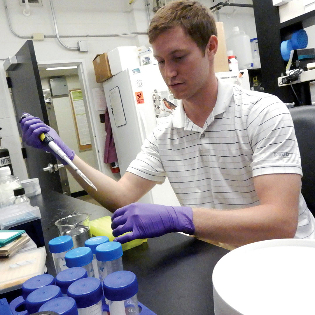How do you carefully remove all of the cells from a lung, and then repopulate that ‘scaffold’ with stem cells from a new host?
As a summer research fellow in the lab of Professor of Medicine Daniel Weiss, M.D., Ph.D., medical student Chris Bernard ‘19 spent several months testing and re-testing processes and procedures, inching ever closer to an answer to that question.

Medical Student Chris Bernard '19 (Photo: LCOM Design & Photography)
How do you carefully remove all of the cells from a lung, and then repopulate that ‘scaffold’ with stem cells from a new host?
As a summer research fellow in the lab of Professor of Medicine Daniel Weiss, M.D., Ph.D., medical student Chris Bernard ‘19 spent several months testing and re-testing processes and procedures, inching ever closer to an answer to that question. Ultimately, the goal of the research is to seed a donated lung scaffold with a patient’s own stem cells to minimize the immune reaction during the transplant process. That donor could be a human, or possibly even an animal, like a pig. Reaching that ultimate goal hinges on fine-tuning how decellularization – an intricate process that can take up to three days – works.
Bernard’s efforts have helped to pinpoint what effectively ensures that the protocol removes and leaves behind the cells, parts and pieces necessary to make the recellularization process a success. Bernard says his experience as a research fellow has been invaluable.
“This is at the forefront of medicine,” he says. “We’re pushing the limits of what human capabilities are, and this lab is doing things no one else does.”